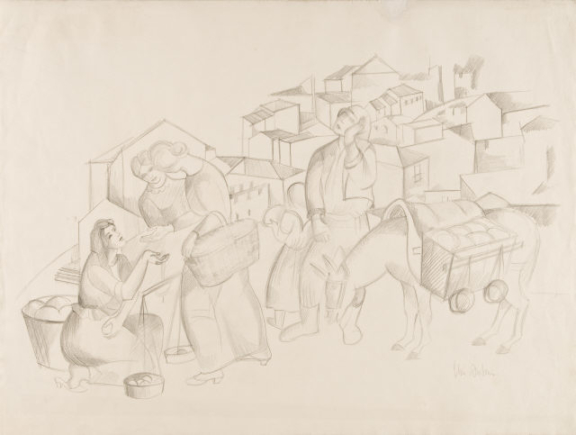
Lino António
s/título
Leiria, 1898 – Lisbon, 1974
In 1918 in Leiria, he organised his first solo exhibition, where his decorative style and ‘modernist technique’ stood out. In the same city, he took part in a gathering which, along with his former master Narciso Costa, also included António Varela, the future architect Luís Fernandes, the multifaceted artist and poet Américo Durão and doctor and writer Américo Cortez Pinto, among others. The first three came together with him in the important group self-portrait which was titled as a manifesto: Nós [Us], 1923. The following year at the Sociedade Nacional de Belas Artes in Lisbon, he held what he effectively considered to be his first solo exhibition and received critical acclaim in Contemporânea and Athena magazines. In this exhibition, he introduced two thematic trends which he would remain faithful to: the coast and its inhabitants, especially Nazaré, and urban life.
Lino António participated in the Autumn Salon I and II at the Sociedade Nacional de Belas Artes in 1925 and 1926. At the same time, the Bristol Club, which was an important venue for Lisbon bohemian and cultural life, underwent renovations and some of Lino António's works were selected for the interior decoration, two of which now belong to CAM: Pintura [Painting] and Natureza-morta [Still Life], as well as A mulher e os galgos [Woman and Greyhounds]. At the end of the 1920s, like many other artists, he illustrated for literary and artistic magazines, particularly for Civilização.
He participated in the Seville Ibero-American Exhibition in 1929 and in the Paris Colonial Exhibition in 1931, as a member of António Ferro's group. He was present at the Independents Salon I and II, in 1930 and 1931. However, the times had changed and, consequently, so did his aesthetic approach, which went from a Cezannian study at the start of the decade to a conventionalism that was closer to the official taste. Lino António sought yet another pictorial language in the 1960s, experimenting with contemporaneity through new forms and processes.
From the end of the 1930s, Lino António started to work on major public commissions, which allowed him to maintain a certain financial freedom, as well as the elegance and well-being he had always valued. Notably, when a group once wanted to honour him with an award he exclaimed, ‘Award? I'd prefer a commission!’ From 1935, António Ferro organised the Exhibitions of Modern Art, with Lino António participating in the first and, the following year, no longer participating in the Exhibition of Independent Modern Artists. In 1938, he painted the frescos on the triumphal arch and choir balcony at Our Lady of Fátima Church in Lisbon. Around this time, he started work on the panels for the Presidential Hall at the National Assembly. He participated in the Portuguese World Exhibition in 1940 as a painter-decorator, as well as in the first Window Dressing Exhibition. In 1944, in the small studio of the government body responsible for propaganda – SPN, he held his last solo exhibition, which was very successful.
It should be stressed that he was a valued and dedicated teacher with considerable reach. He first entered the profession as a general drawing teacher at the Marinha Grande Industrial and Commercial School. In Lisbon, he had tenure as a mechanical drawing teacher at the Machado de Castro Industrial School and, following that, tenure at the António Arroio School of Decorative Arts, later becoming director and head teacher, significantly modernising the curriculum. Lino António was a rare teacher and director in that he had an ‘open door’ policy and took books and magazines from his well-stocked personal library to class, making these resources available to the students. Additionally, in difficult times he defended the school’s freedom.
Some of the other significant public commissions and decorative artworks he created include: the stained-glass windows at the Casa do Douro in Régua, in 1945; the stained-glass windows for the School Chapel at the Handmaids of the Sacred Heart of Jesus in 1946; the frescos and stained-glass windows for the Ceremonial Hall at Vila Franca de Xira City Hall in 1949; the fresco for the chancel at Santo Eugénio church in Encarnação parish in 1951; the polychromatic ceramic panel for the main hall at the National Laboratory of Civil Engineering in 1952; the Stations of the Cross for the portico at the Sanctuary of Our Lady of Fátima, created in collaboration with Querubim Lapa and Manuel Cargaleiro in 1955; the polychromatic ceramic panel for the Faculty of Law at the University of Lisbon; the frescos for the Ceremonial Hall at Covilhã Town Hall in 1957; the ceramic panel and frieze for the Institute of Hygiene and Tropical Medicine in 1958; the ceramic panel for the Military College Student Body Pavilion, also in 1958; the Olisipo tapestry for the Ritz Hotel in 1959; and the frescos for the main hall at the National Library in 1966. The previous year, he had participated in the São Paulo Art Biennial. In 1968, due to the age limit, he was obliged to resign from the position of director at the António Arroio School of Decorative Arts, regretting that he had not been able to make the change from the old to the new school, something which he had hoped and prepared for. Lino António continued to dedicate himself to painting in his last years, briefly revisiting the modernism of his youth.
Sandra Leandro
March 2013